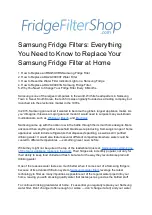
AFW RO System Manual
[10]
Revised 9/09
©Abundant Flow Water System, Inc. 2009
petroleum lubricants.
6.
Repeat step 5 with each housing, replacing the old filter with the similar new filter and checking
the O-rings. If any of the filters have only one gasket (the DI filter on most systems will have
only one gasket) the filter will need to be installed with the gasket at the top of the housing,
unless dictated otherwise by the filter itself.
7.
Once the filters in the housings have been changed, it is time to change the inline post filter. To
replace, remove the tubing and/or fittings from each end of the filter (refer to section on quick
connect fittings near the beginning of the manual if you are unsure how to do this) and replace
in the new filter, paying careful attention to the direction of flow as indicated on the filter, and
ensuring the new filter is installed in the same direction as the old filter.
8.
If the system was unhooked to change the filters, hook it back up now. Open the angle ball
valve on the feed water line and open the tank ball valve.
9.
Open the faucet, and tilt the system back around to help work the air out of the lines
10.
Allow the system some time to start producing water from the faucet, depending on the system
and water pressure this may take up to 30 minutes. When the water first comes out it may be
black as the carbon fines in the post filter rinse out, this is normal. Once you are getting a
steady flow of water (anything from a steady drip to a small stream, depending on membrane
size and water pressure), shut the faucet off.
11.
Allow the system to fill the tank. Depending on the system and water pressure, this can take
anywhere from 1 - 5 hours.
12.
Once the tank has filled, open the faucet, allowing all the water to drain until flow from the
faucet is down to the slow drip or stream seen in step 10. This flushes the system, cleaning the
filters and preparing them for use.
13.
Repeat steps 11-12 at least once to ensure thorough flushing of the new filters.
14.
Your filters are now changed and the system is ready to use again.
Membrane:
The RO membrane will last an average of 2 –4 years, depending on water quality, water usage,
frequency of filter changes, and quality of filters used. Reduced water quality, reduced production
rate, or no production can be an indication of a fouled membrane, but there may not always be
these signs to tell you the membrane is bad. The best way is to monitor the rejection rate of the
membrane using a TDS meter. A functioning membrane should be removing a minimum of 90% of
contaminates under normal conditions. To test this, simply compare the TDS of your tap water to
the TDS of the water from the membrane (before it goes to any other filters). For example, if your
tap water has a TDS of 400ppm, after the membrane your TDS should be 40ppm or less. If you do
not wish to use a TDS meter, we recommended changing your membrane
at least
every 4 years.
To change the membrane:
Note:
The tank will need to be emptied when replacing the membrane. If you would like to save
the water in the tank for use, follow the instructions below, opening the faucet and collecting the
water from the tank
after
turning the feed water off.
1.
Turn off the feed water supply by closing the angle ball valve. The valve is closed when the
handle is at a 90° angle to the tubing (when handle is NOT parallel to tubing). If saving water
from the tank, do so after closing the valve.
2.
Shut the ball valve on the tank. The valve is closed when the handle is at a 90° angle to the
tubing (when the handle is NOT parallel to the tubing).
3.
Open the faucet to release any remaining pressure.







































